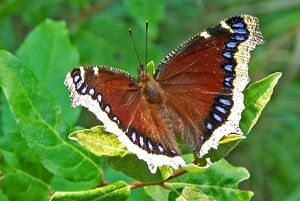Mourning Cloak Butterfly: Difference between revisions
No edit summary |
No edit summary |
||
| Line 25: | Line 25: | ||
Eggs: Mourning cloak eggs are whitish but darken before hatching. | Eggs: Mourning cloak eggs are whitish but darken before hatching. | ||
Larvae: Full-grown mourning cloak larvae are approximately 2.0 inches in length. The head is black with some white | Larvae: Full-grown mourning cloak larvae are approximately 2.0 inches in length. The head is black with some white hair. The body is black and covered in small white dots and numerous white hairs. Most segments have a mid-dorsal reddish-orange patch. | ||
Pupae: Pupae are approximately 0.8 inches in length. They are gray with two rows of ventro-lateral, red-tipped, sharp points. The pupae hang vertically and are attached by the terminal end of a small silk pad [1]. | Pupae: Pupae are approximately 0.8 inches in length. They are gray with two rows of ventro-lateral, red-tipped, sharp points. The pupae hang vertically and are attached by the terminal end of a small silk pad [1]. | ||
Revision as of 11:37, 10 May 2023
The mourning cloak, Nymphalis antiopa, is a large butterfly and one of the most widely distributed butterfly species. It is known as the mourning cloak in North America and the Camberwell beauty in Britain. The name mourning cloak was coined as the butterfly resembles an archaic, traditional cloak worn when someone was in mourning. In northern areas where it overwinters, adults may be seen basking in the sun on warm days. Mourning cloaks are often referred to as the “Harbingers of Spring” as they are some of the first creatures seen in spring.

Taxonomy
Kingdom: Animalia
Phylum: Arthropoda
Class: Insecta
Order: Lepidoptera
Family: Nymphalidae
Genus: Nymphalis
Species: Nymphalis antiopa
Description
Adults: Adult mourning cloaks have a wing span of approximately 3.0 inches. The upper surface of the wings is a deep maroon color with a black band containing a series of powder blue spots and a yellow marginal band. The ventral side of the wings is black, resembling charred wood with a marginal whitish-yellow band.
Eggs: Mourning cloak eggs are whitish but darken before hatching.
Larvae: Full-grown mourning cloak larvae are approximately 2.0 inches in length. The head is black with some white hair. The body is black and covered in small white dots and numerous white hairs. Most segments have a mid-dorsal reddish-orange patch.
Pupae: Pupae are approximately 0.8 inches in length. They are gray with two rows of ventro-lateral, red-tipped, sharp points. The pupae hang vertically and are attached by the terminal end of a small silk pad [1].


Life Cycle
Every year, there is a single generation per year in most areas and possibly a second generation southward. Unmated adults overwinter and mate and lay eggs in the spring. The adults are long-lived and live for almost a year. Males perch and defend territories and fly out to meet potential mates. Adults are known for their graceful gliding behavior, and may feign death if attacked by predators.
Eggs are laid in large clusters in a single layer around stems of host plants. The larvae are sociable throughout their lives and feed within silken webs. When threatened, larvae twitch in unison as a defensive tactic to deter predators. Caterpillars mature in early summer and adults undergo summer dormancy [1].
Range, Habitat, and Diet
The mourning cloak is found throughout North America from Canada to southern South America. It is rare in the Gulf states and in Florida. Mourning cloaks are commonly found in sunny glades, forest borders, parks, gardens, open woodlands, streams, lakes, ponds, and groves. The caterpillar of the mourning cloak feeds in groups on the leaves of deciduous trees. The willow, elm, hackberry, aspen, cottonwood, poplar, rose, birch, hawthorne, and mulberry are common feeding trees. The adult butterfly feeds on tree spa and rotting fruit. It may also consume nectar from flowers [2].

Migration
Mourning cloak butterflies are seen throughout the year because they do not engage in long-distance migration. Instead of migrating, mourning cloak butterflies overwinter. They choose one location where they will hibernate during the winter. Typical locations of overwintering include tree cavities and underneath loose tree bark. Overwinter allows mourning cloaks to begin mating in the spring. This is why they are seen early in spring [3].
Mating
Mourning cloak butterflies display polygynous mating behavior. This is where an individual male will mate with multiple females throughout mating season. Males will use a display site to attract females or fly around searching for females. The male will also defend desirable areas, or areas that offer an increased probability of finding females. The more desirable territories will increase the males' chances of reproductive success. Locations of choice include sunny perches near ravines, wood margins, parks, gardens, lakes, ponds, and around stream edges where males can perch for multiple days.
Spring marks the beginning of the mourning cloak mating season. Female mourning cloaks will find a host plant, usually a tree in the Salicaceae family, and lay their eggs [3].
References
[1] Hall, Donald W, and Jerry F Butler. “Mourning Cloak Butterfly.” Mourning Cloak - Nymphalis Antiopa (Linnaeus), entnemdept.ufl.edu/creatures/bfly/mourning_cloak.htm. Accessed 10 May 2023.
[2] “Mourning Cloak - Nymphalis Antiopa: Wildlife Journal Junior - Wildlife Journal Junior.” New Hampshire PBS, nhpbs.org/wild/mourningcloak.asp. Accessed 10 May 2023.
[3] “Mourning Cloak (NPS Wolf Trap National Park for the Performing Arts Butterflies and Moths) · INATURALIST.” iNaturalist, www.inaturalist.org/guide_taxa/365828. Accessed 10 May 2023.